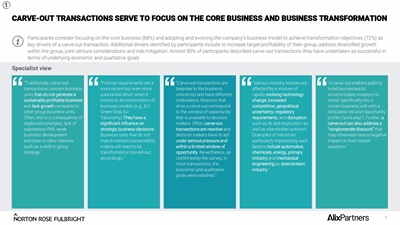
8
Specialist view
CARVE-OUT TRANSACTIONS SERVE TO FOCUS ON THE CORE BUSINESS AND BUSINESS TRANSFORMATION
Participants consider focusing on the core business (88%) and adopting and evolving the company's business model to achieve transformation objectives (72%) as
key drivers of a carve-out transaction. Additional drivers identified by participants include to increase target profitability of their group, address diversified growth
within the group, joint venture considerations and risk mitigation. Almost 80% of participants described carve-out transactions they have undertaken as successful in
terms of underlying economic and qualitative goals
"Traditionally, carve-out
transactions concern business
units that do not generate a
sustainably profitable business
and lack growth compared to
other group business units.
Often, this is a consequence of
neglected synergies, lack of
substantive PMI, weak
business development
activities or other reasons
such as a shift in group
strategy."
"Carve-out transactions are
bespoke to the business
concerned and have different
motivations. Reasons that
drive a carve-out correspond
to the window of opportunity
that is available to decision
makers. Often, carve-out
transactions are reactive and
decision makers have to act
under serious pressure and
within a limited window of
opportunity. Nevertheless, as
confirmed by the survey, in
most transactions, the
economic and qualitative
goals were satisfied."
"A carve-out enables publicly
listed businesses to
accommodate investors to
invest specifically into a
certain business unit with a
dedicated risk and opportunity
profile ("pure play"). Further, a
carve-out can also address a
"conglomerate discount" that
may otherwise have a negative
impact on their overall
valuation."
"Various industry sectors are
affected by a mixture of
rapidly evolving technology
change, increased
competition, geopolitical
uncertainty, regulatory
requirements, and disruption
such as AI and digitization as
well as shareholder activism.
Examples of industries
particularly impacted by such
factors include automotive,
chemicals, energy, primary
industry and mechanical
engineering as downstream
industry."
"Political requirements are a
more recent but even more
substantial driver when it
comes to decarbonization of
business models (e.g., EU
Green Deal, EU
Taxonomy).They have a
significant influence on
strategic business decisions.
Business units that do not
match relevant sustainability
criteria will need to be
transformed or carved-out,
accordingly."
1